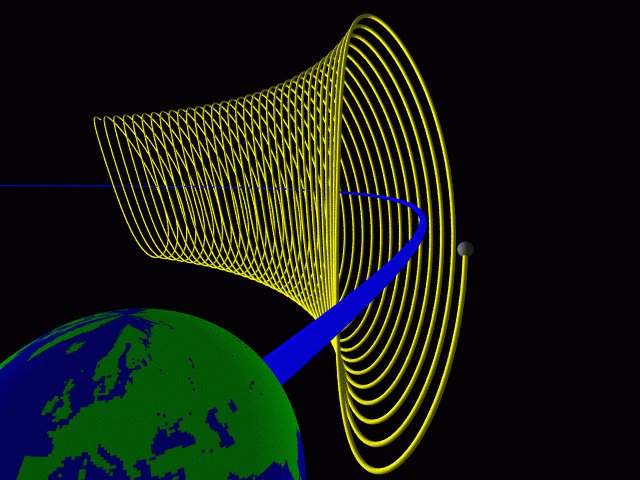Basically co-orbital bodies are objects that share an orbit but are too far apart for one to be a natural satellite or true moon. Even very large planets can't completely clear all of the debris out of their orbits. In fact, they create special opportunities for co-orbital bodies at what are known as the five Lagrange Points and through resonant orbits.
True Moons
Before we talk of false moons, we need to be sure of true moons. Natural satellites or true moons orbit inside a volume of space known as a Hill Sphere. This is where the gravity of a planet or other object dominates the gravity of a second more massive object like the Sun. It might help a bit to think of water running down a drain in a basin with two drains - the whirlpool is a little bit like a Hill sphere. (I'm sure there are problems with this analogy but it might make an interesting school science experiment.)
There are two points on the surface of a Hill Sphere where the gravity of the two main objects is in balance. These points are known as L1 and L2 and for the Earth-Sun system the sphere is about 1.5 million km (or 0.01 AU) in radius. While there are a number of types of orbits that will keep an object at L1 and L2, these aren't stable places and asteroids wouldn't remain there for long. However, it does turn out that L1 and L2 are very useful places to put satellites.
In practice a moon will be found well within the Hill Sphere of a planet.
Trojans (and Greeks)
The first and simplest type of false moon are called Trojans. These objects orbit at or near the L4 and L5 Lagrange Points which are placed equally forward and behind a planet on it's orbit forming an equilateral triangle with the two major objects (such as Earth-Sun or Jupiter-Sun).
The first Trojan asteroid was discovered in 1906 and named Achilles ( orbit diagram, Wikipedia ). Achilles, which leads Jupiter, and its fellows at L4 became known as the Greeks camp or the Greeks. And the Jupiter trailing asteroids at L5 became known as the Trojan Camp. There are even a couple of "spies" that were named before the convention was agreed upon.
Whenever you have one body in orbit around another you will have these points. It can be relative to a star and planet like the Sun and Jupiter, or even a planet and its moons. Saturn's moons Tethys and Dione each have Trojan moons. In theory, there could even be Trojan planets that could arise in situations like binary star systems.
Other than Jupiter, both Mars and Neptune have know Trojans. Earth has no know Trojans. Wikipedia has a list of objects at Lagrange Points.
And if you're wondering why I haven't mentioned the L3 Lagrange Point. That point lies on the opposite side of the larger object. Anything near there would be unstable. Beyond some science fiction like Journey to the Far Side of the Sun, there's nothing there.
Weird orbits - Truth is stranger than fiction
Finally, there are a variety of objects with very strange orbits. Some of these are called Quasi-Satellites with orbits that have been described as Horseshoe or Tadpole and Corkscrew shaped. Stranger still, some of these switch back and forth. Below are some of these:
- 3753 Cruithne ( orbit Diagram, Wikipedia), sometimes described as Earth's second moon, follows one of these orbits. There is an interesting simulation over at the orbit and gravity simulator here that shows the long term effect much better.
- 2009 BD ( orbit Diagram, Strange Asteroid 2009 BD Stalks the Earth | Universe Today) a recently discovered Earth Stalker. Try centering on the Earth and zooming in all the way, hit play and watch the race. Remember, Earth's Hill Sphere has a radius of about 0.01 AU - you can see that BD doesn't get that close.
- 2003 YN107 ( orbit Diagram, Wikipedia) a small corkscrew meteoroid that switches between corkscrew and horseshoe orbits.
- (164207) 2004 GU9 ( orbit Diagram, Wikipedia) a large 200+m corkscrew asteroid with a very stable long term orbit.
- 2002 VE68 ( orbit Diagram, Wikipedia) A long term companion for Venus.
Suspected space junk with weird orbits
These aren't in the orbits database but may be of interest:
Related Articles - Elsewhere
- Quasi-Satellite information page - Uneversity of Western Ontario, Paul Wiegert - good info, animations, and movies of various co-orbitals
- Cork-screw asteroids - NASA
- The moon that went up a hill and came down a planet | Bad Astronomy - why the moon isn't a planet but could be if ...
- Pluto's big hill to climb | Bad Astronomy - a discussion of why orbital dynamic characteristics like clearing the neighbourhood and Hill spheres probably shouldn't be used to classify planets






No comments:
Post a Comment